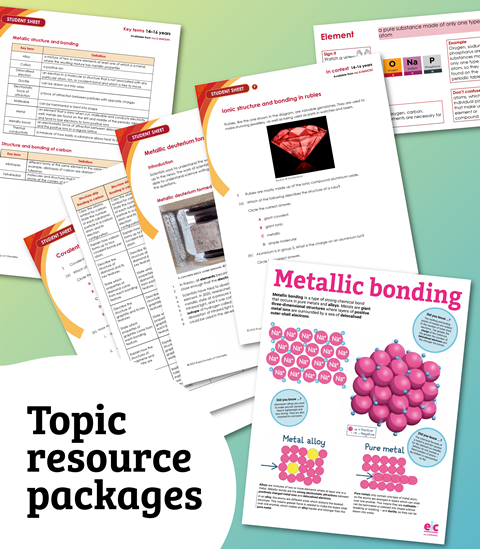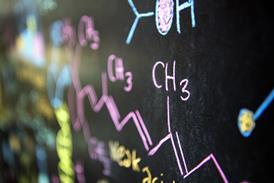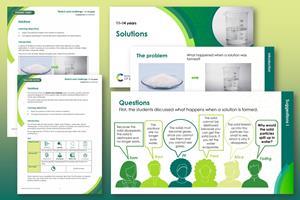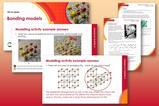Develop critical thinking skills with this discussion-based activity
This activity helps learners develop their working scientifically skills as they discuss experimental results.
Learning objectives
- Apply the particle model in the context of solutions.
- Use logical reasoning to choose between explanations for observations.
Introduction
This activity helps develop learners’ higher order thinking – particularly critical thinking skills – in the context of solutions. Learners must apply some knowledge of he particle model and logical reasoning to simple experimental observations.
Encourage learners to think in terms of reasoning and logic rather than simply reciting facts.
How to use this resource
- When to use? Use as part of more general work on dissolving and solutions.
- Group size? Give this activity to a whole class or part of a class
- How long? 20–30 minutes
When learners have completed the worksheet, give them the Discussion of answers sheet. They can check their own work or peer review the work of another learner or group.
Discussion of answers
1. a) Sam is incorrect to think that the particles of sodium chloride are destroyed. They are simply being rearranged. Instead of being grouped together, in the solid, they are spread out into the solution. This touches an important concept in science, which is that the particles are never destroyed. In chemical reactions, the particles get rearranged but are not created or destroyed. Lucy is therefore correct and pointed out an important piece of evidence to back up her idea.
Ravi’s statement is correct. The solutions are mixtures.
Jo’s statement is incorrect but is not as far from the truth as you might think. Gases are clear, transparent and invisible (unless coloured) because the particles are spread out in an irregular arrangement. The sodium chloride disappears when it dissolves because the particles spread out in the water and end up in an irregular arrangement.
Alice is correct; the particles are much too small to see.
(b) To answer Tom’s question, we need to consider the forces of attraction between particles in both the solid and solution. Particles attract each other. The sodium particles attract the chloride particles and vice versa. There must be forces of attraction between the water particles and the sodium chloride particles. The forces must be sufficiently strong to overcome the forces of attraction holding the sodium and chloride particles to each other.
2. (a) The answer to this is open for debate, but I put Ravi’s statement first, as it shows the greatest reasoning. The sodium chloride particles appear white when they are all grouped together and colourless when they are spread out. So, it seems logical to suggest that the whiteness is caused by the grouping together. Jo and Sam both shed light on the contrast with copper sulfate. It seems reasonable to suggest that copper sulfate’s blue colour is caused in a different way from sodium chloride’s whiteness because copper sulfate solution keeps the blue colour. Notice that we can make this logical statement, even if we know nothing about how copper sulfate appears blue! Alice’s statement is helpful, scientists look for similar situations that they have met, to help explain or make predictions about the part of science they are considering.
Tom and Lucy are both correct. ‘Clear’ is the opposite of cloudy. When solids fully dissolve, they form clear solutions. A cloudy appearance is good evidence that some solid has not dissolved. The solution was also colourless. These are accurate descriptions but do not show as much reasoning as the others.
(b) It would seem reasonable to suppose, from particle theory, that copper sulfate gas would be a very pale blue. Blue, because the particles are blue. Pale, because in a gas the particles are spread out, far apart from each other. However, if you tried to show this by an experiment in the laboratory you would find a few surprises. When (hydrated) copper sulfate is heated strongly, it first loses water (water of crystallisation) and turns white. This suggests that the blue appearance depends on the copper having some water with it. If copper sulfate is further heated it decomposes into simpler substances, gases are formed but they are not copper sulfate. This implies that copper sulfate will not exist as a gas.
Why does the particle model let us down when making a prediction about copper sulfate gas? The particle model assumes that the particles remain the same in the solid, liquid and gaseous states. In the different states, the same particles are simply arranged and move differently. But in chemical reactions new substances are formed – i.e. different particles are produced. So, when you heat a solid, two things might happen: a physical change such as melting or a chemical change like decomposition.
The question has tested the limits of the model we were using to explain our observations. To understand what really happens to copper sulfate we need to introduce a different model. The process of testing a model until we find situations where it lets us down is frequently involved when new ideas in science emerge. It is the process that Einstein used to help develop his Theory of Relativity.
So don’t be disappointed if you get an unexpected result.
3. (a)
i. The hydrated copper(II) sulfate changes when it is heated.
ii. When it is heated the blue hydrated copper(II) sulfate loses water.
iii. The hydrated copper(II) sulfate contains water.
iv. The white residue is copper sulfate with no water – anhydrous copper(II) sulfate.
v. The copper(II) sulfate needs water to be blue – without water it is white.
vi. Sodium chloride crystals have no water since they are already white.
vii. Coloured compounds will change to white when heated if they lose water.
(b) There does seem to be a link between copper sulfate being blue and the presence of water. Copper sulfate solution is blue and so are the hydrated crystals (which do indeed contain some water). Since the blue colour disappears when the water is driven off by heating it seems reasonable to infer that ‘the copper(II) sulfate needs water to be blue – without water it is white’.
(c) ‘Sodium chloride crystals have no water since they are already white.’ Sodium chloride solution is colourless. There is no evidence that water gives colour to sodium chloride.
‘Coloured compounds will change to white when heated if they lose water.’ This is too general a conclusion for just one substance. You would need many more examples before stating a general trend as Alice has.
Downloads
Solutions slides
Handout | PDF, Size 1.72 mbSolutions student sheet
Handout | PDF, Size 0.35 mbSolutions teacher notes
Handout | PDF, Size 0.48 mbSolutions slides
Presentation | PowerPoint, Size 8.02 mbSolutions student sheet
Editable handout | Word, Size 1.01 mbSolutions teacher notes
Editable handout | Word, Size 0.65 mb
Additional information
This resource was originally published in the book Chemistry for the Gifted and Talented by Tim Jolliff. The book is no longer available for purchase. However, you can find all the resources on our website.
This resource was reviewed and updated in 2025 by Kirsty Patterson.
























No comments yet